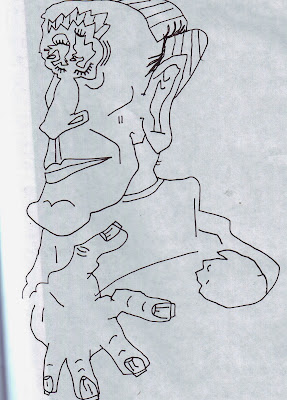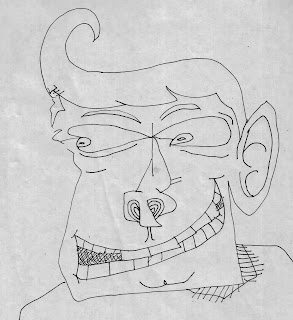I have long, long, long worried—and sometimes, when things feel especially dire, simply resigned myself to the inevitability—that I am related to George Walker Bush. This isn't as unlikely as one might think: Obama and Cheney are eighth cousins; I am the fruit of the same Mayflower as Sarah Palin; Walker was my great-grandmother's maiden name. But it was
the recent piece on Slate about Bush's slave-trading great-great-great-great-great-grandfather that sent my paranoia into overdrive: could I, too, have Thomas "Beau" Walker somewhere in my family tree? So, in a tizzy, I did some digging. I got as far back as
my great-great-great-grandfather, who, I then learned, married my great-great-great-grandmother in Quincy, IL, in 1843.
Which got me thinking. Why would they have been in Quincy, IL, in 1843?
Could they possibly have been Mormons?
If this were so, there is
almost certainly deeper genealogical records I could probe. In the meantime, though, I did some rudimentary Google searches—keywords like "mormon" and "walker" and "quincy" and "1843." Nothing turned up, no smoking gun, but there were some nice little detours, in particular, "
The Mormon Priesthood Ban and Elder Q. Walker Lewis."
This is what brings me to Quacko.
I quote Connell O'Donovan's research at length and bold those names I find especially striking:
Born Quack Walker Lewis on Friday, August 3, 1798 in Barre, Worcester County, Massachusetts to Peter P. Lewis Sr. and Minor Walker Lewis, he was named after his 45 year old maternal uncle, Quacko Walker (who was also born in August, probably on Saturday the 4th, 1753 — Kwaku is Ghanian for "boy born on Saturday", a common naming device among African tribes of the time). Walker was the couple's fourth of eleven children. His older siblings were:
- Samuel Alexander Lewis (1792 -1852); married first Susanna "Sukey" Maldree in 1815 and then Elizabeth Munroe in 1841
- Adam Lewis (1794 -1840s); married ____________
- Sophia Lewis (1796- 1852); married black abolitionist John Levy in 1822
Walker's younger siblings were:
- Rev. Joseph Lewis (1800 - 1852) - clergyman; married Sylvia A. ______ of Rhode Island
- Enoch Lewis (1801 - before 1844); married Azuba Nichols in 1823
- Rosanna V. Lewis (1802 -1826)
- Dinah S. Lewis (1805 - 1860); married first William F. Bassett in 1827 and then Isaac Davidson in 1842
- Andress Valentine Lewis (1806 - 1898); married first Martha Lew in 1832 and then Urania Silver in 1846
- Peter P. Lewis Jr. (1807 -1845); married Relief Ingalls Lovejoy—the sister of Walker's wife—in 1830
- Simpson Harris Lewis (1814 -1887); married Catherine Jackson in 1833, Susan M. Jackson in 1841, Caroline F. Butler about 1845, and Frances Ellen Brown in 1875
Little is known about Peter P. Lewis Sr. until his marriage to Minor Walker in Barre, December 5, 1792. In land records he is called a "yeoman" (gentleman farmer); he was born about 1758 and was from Cambridge, Middlesex County, Massaschusetts.
Minor (or Minah and variants) Walker was born a slave in 1758 on the homestead of her parents' owners, James and Isabel Oliver Caldwell, in Barre (Rutland District), Worcester County, the second child and oldest daughter of slave parents Mingo (also known later as Nimrod Quacko or Quameno) and Dinah. (Minor/Minah is a common African woman's name with various possible meanings; Dinah is a Muslim name; Quameno, from Ghaniankwamin, means "boy born on Wednesday", and Mingo is apparently Bobangi for "defiant one", an apt name as will be shown.)
O'Donovan continues:
The naming practices of this family over the decades are really quite interesting. The first generation of Mingo, Dinah and their first two children, Quacko and Minor, maintained their ethnicity with names of African origin, but beginning with Mingo's third child, the names became somewhat campy, even mocking, apparently imposed on them by their masters—especially for the boys Step, Prince, Boston, and Cato Walker. However, around the time of the American Revolution, the family began using bourgeois New England names and naming practices, perhaps being influenced by the first wave of white abolitionists, the Quakers. Over the next one hundred years the vast majority of names of this and allied families, such as Relief Ingalls Lovejoy or William Bradford Peck, could just as easily have come from some Monthly Meeting records of the Society of Friends. This, ironically, led some Mormon genealogists to believe they were in fact white and had LDS temple ceremonies performed vicariously for many of these people, decades before the ban against this would be lifted.
Now, I am not related to Quacko or Relief or Urania or Andress or Azuba or Cato, though it is true that I am related to people with names like
Mehitabel and Guy, Kitty and Bryson, Winifred and Winifred and Winifred, Sarah and Barbara, Max and John.
Step, Quameno, Nimrod, Louisa,
Helen, Samuel—all names can become wonderful and strange, rich with possibility, entangled in forgotten and imagined and buried histories, if you just look at them the right way.























